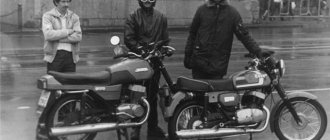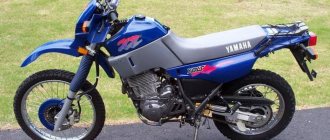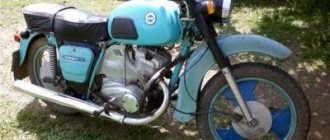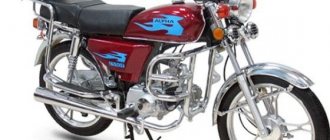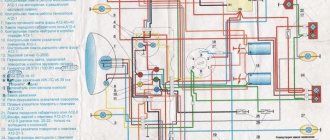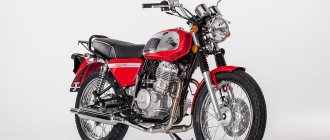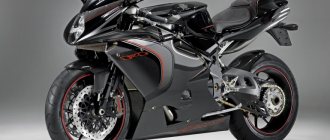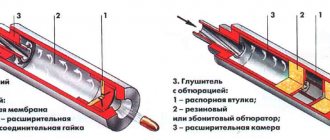For various reasons, you may be the owner of a legendary Java - it’s your father’s, older brother’s motorcycle, or you just bought a legendary vehicle for the occasion. But here’s the problem - the motorcycle is often far from ideal condition, for example, you may be upset by such a nuisance as the wiring of the Java, which has delaminated from old age, was probably stored in an unheated barn or garage, and a new set cannot be found in your city.
There are few well-groomed specimens of Java left
What’s most annoying is that the work of replacing most parts and assemblies is quite simple , but the lack of spare parts immobilizes your vehicle indefinitely. Moreover, the price of parts tends to rise every year, which forces us to show skillful hands and ingenuity. But the result lives up to all expectations.
IL as a donor of spare parts
Let's consider, for example, the transition from 6 volts to 12 volts electrical equipment, and we will borrow the parts for such a conversion from the IZh motorcycle - fortunately, there are quite a lot of them sold in the post-Soviet space.
Note! Motorcycle manufacturer JAWA itself changed the voltage on its next models. This is discussed in more detail in the publication about the wiring of Java 634 and 638. And it would be more logical to use original parts, but, as mentioned above, the lack of spare parts and their exorbitant price do not provide such an opportunity.
The wiring to Java will remain the same - if its condition is satisfactory, but the lamps and coil will have to be replaced. But you will get a more powerful system, which will affect all the characteristics of the motorcycle.
Scheme with decoding
Advice! If you decide to make such a modification, you will also need a Java 12 V wiring diagram, presented above in high resolution (1000x700)
Reasons for alteration:
- Elimination of weak headlight light is a phenomenon common to all Javas with 6V equipment;
- Elimination of undercharging of the battery during prolonged driving at low speeds;
- Breakdowns and failures due to wear of original 6V parts;
- Inability to purchase original components and consumables;
What do we take from the domestic motorcycle industry?
Note! The 12-volt IZh components are quite easy to adapt to the 634 motor with your own hands. That is why this modification should be considered as a working option.
You have to “implant” domestic details into the Java scheme
Advice: There are modifications using parts from Chinese Delta scooters and mopeds. But we do not recommend them, since the quality of the parts is not up to par.
In fact, we will need a minimum set of parts from IZH:
- relay-regulator, indicated in the photo below under No. 1;
- generator rotor (under No. 2);
- stator windings (under No. 3);
- supply wire to the ignition switch at terminal 54 (under No. 4).
For reference: also on the installation diagram of “Izhevsk” parts in the Java electrical circuit, the terminal markings of the relay-regulator block are indicated (from X1 to X8).
Custom parts
A faceplate for a generator - you can order it from a familiar turner.
You can’t do without the help of a turner. If so, then start by searching for him through friends or newspaper advertisements.
You will order him:
- Adapter washer (faceplate) for installing the generator;
- Modification of the stator - the side facing the crankshaft will have to be shortened;
- Groove of the seat.
Note! The stator should not be modified in a garage, because It will be difficult to maintain the bore diameter accurately. And in the future, after assembly, the rotor will probably touch the stator coils, which will lead to their increased wear.
The video below demonstrates the operation of a Java motorcycle with a 12-volt generator from IZH.
This is exactly the result that you will get if you follow the proposed procedure for modernizing your Java.
Operational Features
It was the motorcycle in our country that became a clear confirmation that a two-wheeled vehicle is truly a means of transportation.
The owners and their “iron horses” could be found everywhere:
- In the forest thicket;
- In the mountains;
- On city highways;
- In the rural outback;
- At sports competitions, etc.
On a JAWA motorcycle you could easily travel 1000 km from home.
Its endurance and reliability on the longest routes contributed to such a high popularity of the brand as a whole. Even the resale of a 5-year-old copy brought the former owner at least 500 rubles.
For reference: Purchasing new domestic two-wheeled motorcycles cost more modest sums for the family budget. The shortage of spare parts, missing instructions and minor breakdowns did not stop me from buying my dream motorcycle.
However, difficulties with parts and a simple design contributed to the fact that owners serviced the motorcycles with their own hands in a variety of places:
- In private garages;
- In the back rooms;
- On the balconies;
- In apartments, etc.
The lack of a garage has never been a hindrance to a true motorcycle enthusiast
Alteration work
Let's start working directly in Java.
The modification instructions will be as follows:
- We fasten the faceplate with M6 bolts. We use only with flush-mounted heads, since regular bolts will interfere with the operation of the rotor.
Installing the faceplate
- We install the rotor and check its rotation. It should rotate freely and without play on the axis.
If the faceplate is installed correctly, the rotor will rotate freely
- We clamp it together with the flange under the modulator using a bolt.
- We mount the stator. First, we remove the terminal of the center of the stator windings - it will be needed for the relay for the generator operation indicator lamp.
We bring out the terminals for connecting a car relay from a VAZ 2101 to a control lamp
Note! The use of parts from VAZ is also practiced in modifications to cars of other domestic brands. In particular, the wiring diagram of the UAZ 31514 was built using a switch from a VAZ 2108.
- We connect the wires.
- Install the breaker plate.
Installation of the plate. This option is made with a Hall sensor
Tip: installing an ignition using a Hall sensor makes the moment of sparking more predictable, which improves ignition of the mixture. Since we are modernizing electrical equipment, it makes sense to improve the ignition system at the same time.
That's all. All that remains is to check the functionality of our modernization, for which we start the engine with the cover removed. If necessary, set and adjust the ignition angle.
Motorcycle electrical equipment
Despite the high build quality and durability of the main components and assemblies, the technical condition of the motorcycle had to be constantly monitored.
In particular, regular maintenance was required:
- Battery;
- Ignition systems;
- Fuel supply systems;
- Lubrication systems.
The manufacturer clearly indicated in the documentation the components that require constant attention
Battery
Motorcycles made in Czechoslovakia were equipped with a proprietary TREPCHA 6A5 battery. Its service boiled down to:
- Checking the electrolyte level in each cell;
- Checking its density (nominal value - 1.26 g/cm3);
- Charging the battery when the discharge at the terminals decreases below the permissible values (when fully charged, the voltage is 7.8-8.1 volts). The battery is charged with a current of 0.6 A.
The TREPCHA 6A5 battery was installed under the seat
Wiring
The Java 634 6v wiring diagram also required close attention from the owners.
In particular:
- All wires must be inspected from time to time, and if the insulation is broken or damaged, repaired or replaced.
- Check the spark plug wire. If cracks appeared in the insulation or on the protective caps, the wire should be replaced.
For reference: dirt accumulated in the insulation cracks and served as a bridge for current leakage, which affected the sparking of the ignition system.
- Check the operation of the brake light switch, the drive of which is located quite low to the road surface.
- Check the condition of the 15 A fuse contacts;
- Check the operation of the headlight.
The motorcycle wires had to be carefully monitored
Wiring Java 634: features of the generator and battery of the JAWA motorcycle
And in our harsh operating conditions, the Java 634 wiring and electrical connections quickly became unusable, which forced the owners to find repair methods using available materials.
Factory color wiring diagram Java 634
For reference: this brand appeared in 1973 and was supplied to the USSR until 1982. At first it was the “634” model with 6V equipment, and then it was replaced by the “638” with a 12-volt electrical circuit. The price started at 950 rubles for new equipment, and rarely dropped below 450 rubles for a used copy.
Electrical equipment Jawa 634
(Click on the picture to enlarge)
1— main headlight lamp (6 V, 35+35 W); 2— parking light lamp (6 V, 4 W); 3— direction indicator lamp (6 V, 15 W); 4— lamp for monitoring generator operation (6 V, 2 W); 5 — high beam warning lamp (6 V, 2 W); b — speedometer lighting lamp (6 V, 2 W); 7 - central switch; 8 — turn signal interrupter relay; 9 — sound signal; 10 — switch for low-high beam with a button for turning on the sound signal; 11 — turn signal switch; 12 — capacitors; 13 and 14 — contacts of the ignition interrupter of the left and right cylinders; 15 and 16 — spark plugs; 17 — ignition coils; 18 — brake light switch; 19 — relay-voltage regulator; 20 - battery (6 V, 14 Ah); 21 - generator (6 V, 75 W); 22 - fuse (15 A); 23 — brake light lamp (6 V, 15 W); 24 - parking light lamp in the rear light (6 V, 5 W).
Source
Increasing the voltage: Java wiring with IL parts
For various reasons, you may be the owner of a legendary Java - it’s your father’s, older brother’s motorcycle, or you just bought a legendary vehicle for the occasion. But here’s the problem - the motorcycle is often far from ideal condition, for example, you may be upset by such a nuisance as the wiring of the Java, which has delaminated from old age, was probably stored in an unheated barn or garage, and a new set cannot be found in your city.
There are few well-groomed specimens of Java left
What’s most annoying is that the work of replacing most parts and assemblies is quite simple , but the lack of spare parts immobilizes your vehicle indefinitely. Moreover, the price of parts tends to rise every year, which forces us to show skillful hands and ingenuity. But the result lives up to all expectations.
Wiring Java 634: features of the generator and battery of the JAWA motorcycle
The JAWA brand motorcycle from Czechoslovakia turned out to be super popular in the USSR, especially in an era of general shortage. But not everything was smooth with the supply of spare parts.
And in our harsh operating conditions, the Java 634 wiring and electrical connections quickly became unusable, which forced the owners to find repair methods using available materials.
For reference: this brand appeared in 1973 and was supplied to the USSR until 1982. At first it was the “634” model with 6V equipment, and then it was replaced by the “638” with a 12-volt electrical circuit. The price started at 950 rubles for new equipment, and rarely dropped below 450 rubles for a used copy.
Motorcycle electrical equipment
Despite the high build quality and durability of the main components and assemblies, the technical condition of the motorcycle had to be constantly monitored.
In particular, regular maintenance was required:
The manufacturer clearly indicated in the documentation the components that require constant attention
Battery
Motorcycles made in Czechoslovakia were equipped with a proprietary TREPCHA 6A5 battery. Its service boiled down to:
- Checking the electrolyte level in each cell;
- Checking its density (nominal value - 1.26 g/cm3);
- Charging the battery when the discharge at the terminals decreases below the permissible values (when fully charged, the voltage is 7.8-8.1 volts). The battery is charged with a current of 0.6 A.
The TREPCHA 6A5 battery was installed under the seat
Wiring
The Java 634 6v wiring diagram also required close attention from the owners.
- All wires must be inspected from time to time, and if the insulation is broken or damaged, repaired or replaced.
- Check the spark plug wire. If cracks appeared in the insulation or on the protective caps, the wire should be replaced.
For reference: dirt accumulated in the insulation cracks and served as a bridge for current leakage, which affected the sparking of the ignition system.
- Check the operation of the brake light switch, the drive of which is located quite low to the road surface.
- Check the condition of the 15 A fuse contacts;
- Check the operation of the headlight.
The motorcycle wires had to be carefully monitored
Current consumers
The electrical circuit of motorcycle consumers should be divided into:
Thanks to the ignition coil, they are inductively interconnected - the primary circuit extends from the generator to the ignition switch through contact “51” (in the diagram above) or through the battery (terminal “30”).
When the ignition is turned on (terminal “54”):
- current is supplied to the primary winding of the coil;
- and then from the secondary to the ignition breaker.
For reference: The principle of operation of the ignition coil is to generate high voltage current using the primary and secondary windings, and then supply it to the spark plug, which ignites the air-fuel mixture in the cylinder. This can be clearly seen in the educational video from school physics lessons.
Conclusions: We hope that the diagrams and technical features presented in the article will help you in servicing the electrical circuits of your motorcycle (see also the article about the electrical wiring of the Java 350 for more details). And your “iron horse” will last for decades in good condition.
